Taking care of the Cat | ||
| A look inside Paws, Inc., And at the People Who Bring You Garfield. | ||
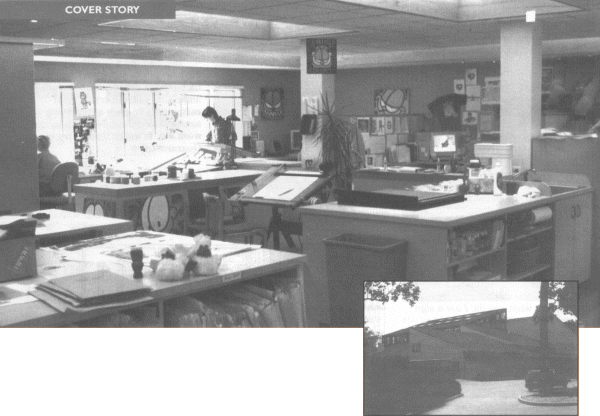
Taking care of the Cat | ||
| A look inside Paws, Inc., And at the People Who Bring You Garfield. | ||

|
The wooded, flat farm lands of Central Indiana reveal all manner of animals, both domestic and wild. During a drive through the outskirts of the remote town of Albany, one expects to see dairy cows grazing, or perhaps a deer scurrying through a thicket. But here also lives a cat -the world knows him as Garfield- who is pampered and provided for by a team of caretakers who inhabit a 36,000 square foot modern office complex on 30 landscaped acres. This is Paws, Incorporated. A bit out-of-place for a multimillion dollar marketing, licensing, and production empire? Perhaps. But here's the question: Where does a best-selling author, multiple-Emmy-Award-winning cartoonist of the most widely read comic strip in the world work? Answer: Anywhere he wants to. End of explanation. Paws, Inc., is the company that evolved from the success of Jim Davis's comic strip Garfield, which debuted in 1978. Nearly twenty years later, Garfield has become one of the enduring comic icons in our culture, with a presence much wider than the confines of newspaper comic pages. Who hasn't seen a Garfield doll, poster, T-shirt, TV show, greeting card, pet supply, etc.? Paws was created in 1981 to service the demand for the Garfield characters' licensed products. Here all things Garfield-related are controlled: artwork, licensing, business affairs, concepts, etc. In 1994, Jim Davis made history by purchasing all rights to his creations from Garfield's original syndicate, United Media -a first for a creator of a major syndicated comic strip. When that happened, Garfield truly came to exist under one roof. Paws, Inc., then, is Garfield command central, and at the helm is Jim Davis. Once upon a time, Jim was just a cartoonist. Today he is "...the CEO of a major company," according to Universal Press Syndicate's Lee Salem, quoted in an article from The Indianapolis Star. And very much a hands-on CEO. "The difference between Jim and me," says Gary Baker, Davis's assistant on the Garfield strip as the penciler, "is that if I were Jim Davis, I would be living near the ocean and phoning in for my check. Jim borders on being a compulsive workaholic and it's because he is so involved that he has all this," he says with a sweeping gesture that encompasses the no-expense spared splendor of a smoke-free work place. Here there is a cafetaria, exercise area and locker room, atrium, animation and recording studio, computer equipment, and an art department with 15 spacious workstations. Everything is top-of-the-line, state-of-the-art. One half expects employees to be able to speak into a lapel microphone and activate doors and lights. It's that kind of place. | ||
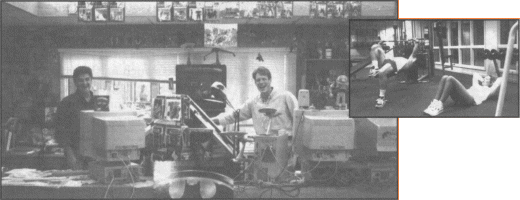
|
|
| Team building The key to commandeering a successful corporation is assembling a team of talent to whom you can delegate responsibility. This Jim Davis has done, steadily adding to a growing company over a 15-year period to a point where, in the mid 90s, he has nearly 60 employees. Jim oversees the direction of his characters and company, making decisions and dreaming ideas, while his employees execute his plans. His one constant involvement is with the comic strip as its main creative force. He cowrites and roughs each episode before passing it along to a team of assistants who produce the finished version. As for other projects, especially art for licensed merchandise, there are simply not enough hours in the day to keep up with the demand. That's why he employees 14 staff artists. | ||


|
|
Not only has he hired people to draw for him, but he has also hired people to cook for him, tend his property, handle his business affairs, and fly his company jet. He even has someone to answer his questions for him. His spokesperson, Kim Cambell, looks one in the eye and reveals a not-too-surprising secret: "There is virtually no turnover at Paws." That's because everyone on the staff at Paws will tell you that this is the best job in the world. The perks, generous salaries and benefit packages are there to keep the employees happy and are based on a business philosophy that says happy employees are the foundation of a successful business. One perk for the Paws artists is unlimited access to facilities for after-hour freelance projects. Indeed, Davis encourages his staff to follow their passion for art outside of work. Many do. They stay over evenings and weekends, using Paws's high-tech computer equipment (both Windows and Mac platforms), stat machine, photocopiers, and art supplies (an honor system allows them to purchase from the company rather than make trips on their own to art stores). The purpose of this is twofold: Davis and the artists agree that drawing something other than the same orange cat keeps the artists frech and motivated, and skills and knowledge learned from outside work can be brought back and applied to projects for Paws. | ||

|
|
|
Davis recognizes that his artists come from various backgrounds in art and have varying aspirations for their talent. Applying their skills to "The Garfield Look" is the purpose of their jobs, but also the frustration to artists who yearn to work in their own styles. To that end, Davis once gave his staff free rein to indulge in a project called The 9 Lives of Garfield. This first saw light as a book, then as an hour-long TV special. The concept comprised nine segments, each representing a different "life" that featured the familiar Garfield character reconfigured in a new style of art and writing. Each reflected the tastes and passions of various staff artists. Projects such as this are a prime example of the degree to which Jim is willing to accommodate his staff members to ensure their happiness. | ||
| Finding talent People wind up at Paws in different ways for different reasons. But once on the job, few leave. The only artists who have left where those for whom, job aside, life in the rural Midwest simply didn't suit. That's how Lynette wound up on staff. Lynette was living and working in California but wanted to return to the roots of her Midwest upbringing. That's exactly what Paws likes to hear from a job applicant. She has been with the company eight years and has no plans to leave. Other artists don't need to move. They are already living in the Central Indiana area, and working at Paws is simply a matter of seeking out the best possible job. That's how Larry Fentz arrived. Had Jim Davis not opened shop, Larry might still be doing his previous job -airbrushing technical illustrations. Gary Baker's presence is a case of Paws becoming aware of his talent end recruiting him for the staff. Gary was working as "Captain Cartoon," a cape-and-tights clad character on a children's TV show who did quick-sketch caricatures. Paws became aware of him and asked if he would like to apply as Jim's assistant. On his father's advice, Gary appeared for his interview immaculately groomed in a three-piece suit. When Jim saw him, his face fell. "We wanted 'Captain Cartoon'!" he said. But they hired Gary anyway, and he has since become something of the art department's point man, who, among other things, ensures that all art produced by the staff conforms to the Jim Davis style. Eric Reaves's presence at the company is the easiest of all to understand. While working for a Garfield licensee, he visited the Paws studios. Impressed, he walked away thinking, This is where I want to work. | ||
|
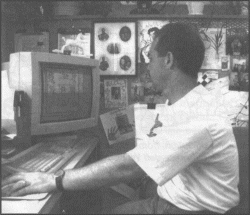
|
|
Eric is also one of the many Paws artists who enjoys an thriving freelance business. "I do outside jobs pretty regularly, " he says. "Not for the money, but because I just love to draw. It gives me a chance to do something different." Eric is a versatile arist who can work in a variety of styles. His role at Paws is as one of two art directors handling art for merchandise and licensed products. He is particularly well-suited for cases where Garfield will wind up on clothing. His background is in the licensed-character apparel industry. He does lots of apparel art for his freelance jobs, too. He also does illustrations for publications and products, such as Teenage Mutant Ninja Turtles sleeping bags and plastic tents. One of his more passionate off-hours pursuits is attempting to emulate Jim Davis and create his own syndicated comic strip. "That would be the ultimate," he says of his career goal. "Working at Paws has taught me a lot about the presentation of a strip -how to lay it out and what to leave in and take out." He confesses that writing is still a struggle. For his most recent effort he has collaborated with a writing partner and produces a Sundays-only style feature titled Bible Adventures. "It's targeted for the religious sections of large-circulation newspapers," he explains. "Hopefully a syndicate will see this as something not yet being tried and give it a chance." Does working for the number one syndicated comic strip give him an inside line? "I certainly mention that fact in my cover letter," he responds, "but I doubt it affects the syndicate's decision. Being at Paws does help me in making contacts and knowing the people at the syndicates." Gary Baker also has aspirations beyond Paws. He would eventually like to teach cantooning. "There are so many kids out there who want to learn how to draw comic book art and very few places to learn," he says. He feels being at Paws is preparing him for his goal because of his on-the-job training in computer graphic software. He is a pencil and paper loyalist who is just beginning his computer learning curve because he sees it as a tool that can't be ignored -especially by one who wants to teach cartooning. Paws has benefited Gary in other ways. "I've learned shortcuts and discipline with my art. Working with Jim has taught me a lot about economizing. Before working here, I had a tendency to draw way too much, and it "muddied" the final look. Deadlines on a daily strip force you to work quickly and learn to convey things with as little information as possible." 13 years as an assistant on a syndicated comic strip is not how Gary had envisioned his career. A childhood passion for comic books fueled a lifelong desire to work in that industry. And he has, freelancing for DC, Dark Horse, and Marvel, where his most visible work has featured The Hulk. A long-time goal has always been to work on Superman, something he recently accomplished with a job doing 3-D designs for a sculptured coin bank. Getting established in the comic book industry was a struggle for one who was known as "The Garfield Artist.""They thought that because I did something 'cartoony' that I couldn't do other things. So I had to work extra hard to prove that I could," he says. Lately, he has slowed down a bit with the freelancing. "Working in comic books was something I always wanted to do, until I did it and realized maybe that wasn't the case," he says. Putting in 12-hour days seven days a week doesn't jibe with a growing desire to enjoy life away from the workplace. "Plus, if I freelanced comic books full-time out of the home, I would never get anything done. I like getting up, showering, and going some place to work. It gives my life structure." | ||

|
|
Whereas Gary Baker's specialty is drawing, Larry Frentz brings airbrushing skills to the talent pool. He is primarily employed as an embellisher, inking lines and adding colors to the drawings passed his way in the assembly line process. Larry is a self-taught artist and benefited from having the right skills at the right time to get hired at Paws. "Jim had an idea for how he wanted the art to look at the same time I sent in my portfolio of airbrush work," he recalls. "Having done cutaways of turbine engines and photo-retouching, being here lets me be a little looser and use bold colors. It's made my work more fun and easier." He has also learned on the job. "I learned how to ink with a brush," he says holding up a Winsor & Newton Series 7, something of the "house" brush used by all the artists at Paws. His other workplace tools are an Iwata airbrush and about 100-custom mixed color pigments of varying values. He used to use transparant dyes, but prefers Winsor & Newton gouache as a more versatile medium. "Another thing this job has taught me is more about mixing colors and using complementary colors," he says. The on-the-job training will continue with computerized coloring. He recently had a Mac set up in his work station. "I'm not looking forward to it because I don't understand it," he admits. "But if that's the wave of the future, then it's worth learning." |
|||||
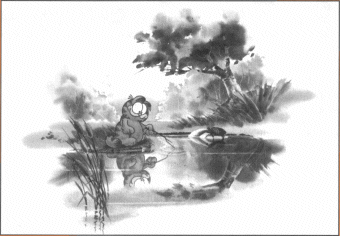 |
Another of Larry's specialties is watercolors. His goal for his off-hours art is to become more accomplished in that medium, mainly as a recreation. He has applied his water coloring background at Paws to such things as the 1989 Garfield Calendar, where he set the familiar cat among traditional landscapes. As far as freelance jobs go, he largerly applies the same skills he uses at Paws to outside projects. He has inked and colored a variety of coloring book covers and children's books. Larry Fentz applied his watercoloring background to 13 pieces for the 1989 Garfield Calendar. |
||||
|
Unlike Larry Frentz, Lynette Nuding uses a single tool: a non-repro blue pencil. Her job is to "blue-line" all the art that needs it -ensuring it remains "on-character"- before it is passed along to the next stage of embellishing. Away from the job (if you can call it that, since, "I'm here day and night using the facilities."), Lynette works in a singularly strong style that reveals her background. "I was always interested in stylized 'design-y' kind of drawing and wanted to apply that to a career," she says. "I went to fine arts school, and they suggested I should go to animation." She wound up with a degree from Cal Arts and a West Coast career that found her working for Hanna-Barbera, Marvel, and Bill Melendez Productions. It was while she was at the latter job that an opportunity arose to work for Paws. "I consider this the best job I could have without working for myself, and even working for yourself has drawbacks that aren't present here," she says, refering to the perks and camaraderie among her Paws counterparts. |
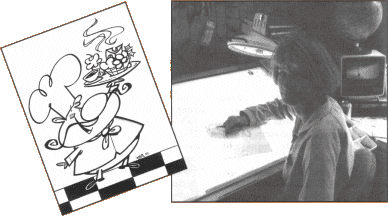
|
|||||||||||||
|
Her distinctive style emerges in freelance work for a number of clients. "One of the great things about freelancing at Paws," she reveals, "is that you pick up jobs turned down by some of the other employees. That's how I got hooked up with the Indiana Roller-skating Society," for whom she does regular design and illustration work. Eric Reaves seconds the value of freelancing amid his co-workers. "Nobody here is a slouch. When you work in a room full of people as talented as these, it rubs you off. You keep growing and never get to the point where you are stale and stagnant," he says. "Paws has so much talent to pull from." |
||||||||||||||

|
|

